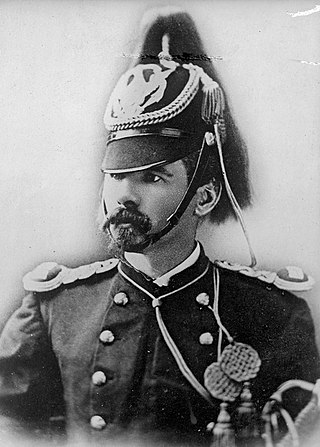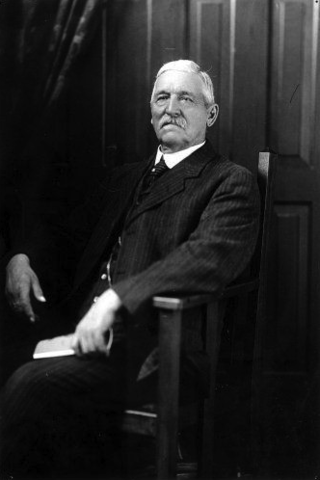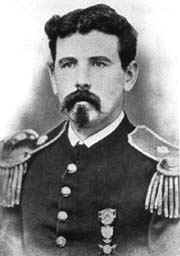
The Tongue River is a tributary of the Yellowstone River, approximately 265 mi (426 km) long, in the U.S. states of Wyoming and Montana. The Tongue rises in Wyoming in the Big Horn Mountains, flows generally northeast through northern Wyoming and southeastern Montana, and empties into the Yellowstone River at Miles City, Montana. Most of the course of the river is through the beautiful and varied landscapes of eastern Montana, including the Tongue River Canyon, the Tongue River breaks, the pine hills of southern Montana, and the buttes and grasslands that were formerly the home of vast migratory herds of American bison.

The Battle of the Rosebud took place on June 17, 1876, in the Montana Territory between the United States Army and its Crow and Shoshoni allies against a force consisting mostly of Lakota Sioux and Northern Cheyenne Indians during the Great Sioux War of 1876. The Cheyenne called it the Battle Where the Girl Saved Her Brother because of an incident during the fight involving Buffalo Calf Road Woman. General George Crook's offensive was stymied by the Indians, led by Crazy Horse, and he awaited reinforcements before resuming the campaign in August.

The Sioux Wars were a series of conflicts between the United States and various subgroups of the Sioux people which occurred in the later half of the 19th century. The earliest conflict came in 1854 when a fight broke out at Fort Laramie in Wyoming, when Sioux warriors killed 31 American soldiers in the Grattan Massacre, and the final came in 1890 during the Ghost Dance War.

Myles Walter Keogh was an Irish soldier. He served in the armies of the Papal States during the war for Italian unification in 1860, and was recruited into the Union Army during the American Civil War, serving as a cavalry officer, particularly under Brig. Gen. John Buford during the Gettysburg Campaign and the three-day Battle of Gettysburg. After the war, Keogh remained in the regular United States Army as commander of I Troop of the 7th Cavalry Regiment under George Armstrong Custer during the Indian Wars, until he was killed along with Custer and all five of the companies directly under Custer's command at the Battle of the Little Bighorn in 1876.

The Battle of Wolf Mountain was a battle fought on January 8, 1877, by soldiers of the United States Army against Lakota Sioux and Northern Cheyenne warriors during the Great Sioux War of 1876. The battle was fought in southern Montana Territory, about four miles southwest of modern-day Birney, Montana, along the Tongue River.
Wooden Leg was a Northern Cheyenne warrior who fought against Custer at the Battle of the Little Big Horn.
The Battle of Cedar Creek occurred on October 21, 1876, in the Montana Territory between the United States Army and a force of Lakota Sioux Native Americans during the Great Sioux War of 1876. The battle broke out after talks between Colonel Nelson A. Miles and Chief Sitting Bull broke down, and ended with surrender of 400 Lakota lodges to Miles six days later.
James Joseph Bell was a United States Army soldier who received the Medal of Honor during the Indian Wars. His name is sometimes incorrectly given as James M. Bell.

The area that eventually became the U.S. state of Montana played little direct role in the American Civil War. The closest the Confederate States Army ever came to the area was New Mexico and eastern Kansas, each over a thousand miles away. There was not even an organized territory using "Montana" until the Montana Territory was created on May 26, 1864, three years after the Battle of Fort Sumter. In 1861, the area was divided between the Dakota Territory and the Washington Territory, and in 1863, it was part of the Idaho Territory.

The Great Sioux War of 1876, also known as the Black Hills War, was a series of battles and negotiations that occurred in 1876 and 1877 in an alliance of Lakota Sioux and Northern Cheyenne against the United States. The cause of the war was the desire of the US government to obtain ownership of the Black Hills. Gold had been discovered in the Black Hills, settlers began to encroach onto Native American lands, and the Sioux and the Cheyenne refused to cede ownership. Traditionally, American military and historians place the Lakota at the center of the story, especially because of their numbers, but some Native Americans believe the Cheyenne were the primary target of the American campaign.
Fort Shaw was a United States Army fort located on the Sun River 24 miles west of Great Falls, Montana, in the United States. It was founded on June 30, 1867, and abandoned by the Army in July 1891. It later served as a school for Native American children from 1892 to 1910. Portions of the fort survive today as a small museum. The fort lent its name to the community of Fort Shaw, Montana, which grew up around it.

Miles City is a city in and the county seat of Custer County, Montana, United States. The population was 8,354 at the 2020 census.
Fort Custer was established during the Indian wars in the Department of Dakota by the U.S. Army to subjugate the Sioux, Cheyenne and Crow Indians near present-day Hardin, Montana. The post was named for General George Armstrong Custer who died at the Battle of the Little Big Horn.

Crow scouts worked with the United States Army in several conflicts, the first in 1876 during the Great Sioux War. As the Crow Nation was at peace with the United States at that time, the army was able to enlist Crow warriors to help them in their encroachment against the Native Americans with whom they were at war. In 1873, the Crow called for U.S. military actions against the Lakota people they reported were trespassing into the newly designated Crow reservation territories.

Fort McKinney (1877–1894) was a military post located in North Eastern Wyoming, near the Powder River.

White Swan (c.1850—1904), or Mee-nah-tsee-us in the Crow language, was one of six Crow Scouts for George Armstrong Custer's 7th Cavalry Regiment during the 1876 campaign against the Sioux and Northern Cheyenne. At the Battle of the Little Bighorn in the Crow Indian Reservation, White Swan went with Major Reno's detachment, and fought alongside the soldiers at the south end of the village. Of the six Crow scouts at the Battle of the Little Bighorn, White Swan stands out because he aggressively sought combat with multiple Sioux and Cheyenne warriors, and he was the only Crow Scout to be wounded in action, suffering severe wounds to his hand/wrist and leg/foot. After being disabled by his wounds, he was taken to Reno's hill entrenchments by Half Yellow Face, the pipe-bearer (leader) of the Crow scouts, which no doubt saved his life.

Grant Prince Marsh was a riverboat pilot and captain who was noted for his many piloting exploits on the upper Missouri River and the Yellowstone River in the Western United States from 1862 until 1882. He began working as a cabin boy in 1856, eventually becoming a captain, pilot, and owner in a career lasting over sixty years. During that time, he achieved an outstanding record and reputation as a steamboat captain, serving on more than 22 vessels. His piloting exploits became legendary and modern historians have referred to him as "possibly the greatest steamboat man ever", "possibly the greatest [steamboat pilot] ever", "possibly the finest riverboat pilot who ever lived", and "the greatest steamboat master and pilot on both the Missouri and Yellowstone Rivers".
The Yellowstone Expedition of 1873 was an expedition of the United States Army in the summer of 1873 in Dakota Territory and Montana Territory, to survey a route for the Northern Pacific Railroad along the Yellowstone River. The expedition was under the overall command of Colonel David S. Stanley, with Lieutenant Colonel George A. Custer second in command.
The Battle of Pease Bottom, also called the Battle of the Bighorn River was a conflict between the United States Army and the Sioux on August 11, 1873, along the Yellowstone River opposite the mouth of the Bighorn River near present-day Custer, Montana. The main combatants were units of the 7th U.S. Cavalry under Lieutenant Colonel George Armstrong Custer, and Native Americans from the village of the Hunkpapa medicine man, Sitting Bull, many of whom would clash with Custer again approximately three years later at the Battle of the Little Big Horn in the Crow Indian Reservation.

Arikara scouts were enlisted men from the Arikara Nation serving in the U.S. Army at different frontier posts in present-day North Dakota from 1868 to 1881. The enlistment period was six months with re-enlistment possible. Each scout received a uniform, firearm and drew rations. Scout duties ranged from carrying mail between commands to tracking down traditional enemies perceived as hostile by the Army in far ranging military campaigns. Detailed to secure the horses in located enemy camps, the scouts were often the first to engage in battle. The Arikara took part when the Army protected survey crews in the Yellowstone area in the early 1870s. They participated in the Great Sioux War of 1876 and developed into Colonel George Armstrong Custer's "… most loyal and permanent scouts …".

























